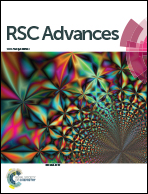Direct synthesis of phenol by novel [FeFe]-hydrogenase model complexes as catalysts of benzene hydroxylation with H2O2†
Abstract
Three new [FeFe]-hydrogenase model complexes, μ-(SCH(CH2CH3)CH2S)–Fe2(CO)6 (complex 1), μ-(SCH(CH2CH3)CH2S)–Fe2(CO)5PCy3 (complex 2) and μ-(SCH(CH2CH3)CH2S)–Fe2(CO)5PPh3 (complex 3) were prepared. The structures of complexes 1–3 were characterized by FT-IR, UV-vis, 1H, 13C, 31P NMR spectra and single-crystal analyses. The electron density of these model complexes was studied by IR spectra, UV spectra and electrochemical analysis and evaluated against their respective catalytic performances. The CV (cyclic voltammetry) study of complex 2 showed a less positive oxidation event at 0.6 V and a more negative reduction event at −1.94 V, which is in accordance with the enlargement of electron density at diiron centers when CO were substituted by better electron donor ligands. Of all these three complexes, complex 2 exhibited the best catalytic activity, with a yield of phenol of up to 24.6% and selectivity up to 92%, which is consistent with its higher electron density of the Fe–Fe bond. This study revealed the correlations between the electron density of the catalytic site of catalysts and their performance in catalytic hydroxylation of benzene. Based on these experimental results, a catalytic oxidation mechanism via an Fe2+–μ-O–Fe2+ intermediate as oxygen transfer reagent has been proposed.
![Graphical abstract: Direct synthesis of phenol by novel [FeFe]-hydrogenase model complexes as catalysts of benzene hydroxylation with H2O2](/en/Image/Get?imageInfo.ImageType=GA&imageInfo.ImageIdentifier.ManuscriptID=C6RA27831K&imageInfo.ImageIdentifier.Year=2017)


 Please wait while we load your content...
Please wait while we load your content...